Forum Replies Created
-
AuthorPosts
-
 Hugh AllenParticipant
Hugh AllenParticipant stacked spectrum image.png)
Hi Robin
Here is the stacked spectrum after geometric correction with the slit oriented vertically through the centre of the coma and upwards into the tail region. It is possible to see the sodium emission extending upwards into the tail region
Cheers
Hugh
 Hugh AllenParticipant
Hugh AllenParticipant spectrum at 22.00UT on 20200716.png)
I captured an Alpy spectrum of the bright coma and adjacent tail on Thursday evening. I removed the sky background from the spectrum but I didn’t attempt to subtract the solar spectrum from sunlight reflected off the dust in the coma. So the sodium emission will be weakened a little by that, but I think only by a very small amount. Compared to spectra taken a week or two ago, the yellow sodium emission certainly has weakened considerably relative to the blue-green C₂ emission bands, hence the subtle change in colour I think. In my comparison it can be seen how the sodium emission persists out into the tail whilst the molecular emission bands fall away in intensity. Visually the tail was huge, extending far from the bright nucleus especially in averted vision – a beautiful sight!
Hugh
 Hugh AllenParticipant
Hugh AllenParticipant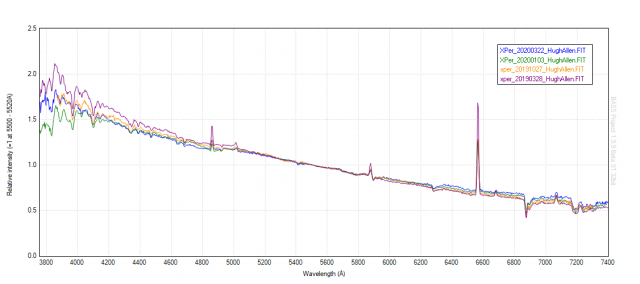
Maybe a slight reddening as the Hα emission has declined
 Hugh AllenParticipant
Hugh AllenParticipant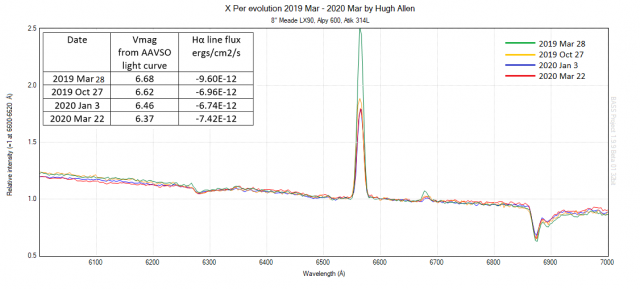
Hi Robin,
Based on the relative peak intenstity of the Hα emission I saw the same trend. The relative intensity plateaued during the first 3 months of this year after falling during last year. However, when I convert to absolute flux using the Vmag measurements in the AAVSO database then the Hα flux looks to have increased a little in my last spectrum at the end of March this year, but probably with a significant error margin.
Cheers
Hugh
 Hugh AllenParticipant
Hugh AllenParticipantI’ve continued to follow the evolution of the spectrum of Betelgeuse, taking advantage of this quite incredible run of clear weather. My last observation was on Thursday evening with Betelgeuse at an altitude of about 30deg as it just about got dark enough – I think this could be my last reliable observation before it disapppears into twilight.
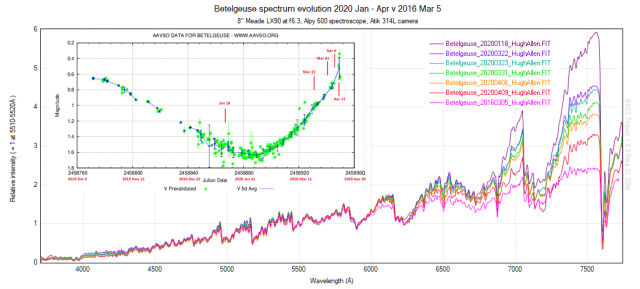
The deep fade in January corresponded with a significant increase in relative brightness in the near infrared which is now declining back to the state in my spectrum of 2016 Mar 5 when the V mag was also near the current ~0.5. To ensure reliable response correction in the shape of the spectra I captured the nearby B5V star HD 36267 from Francois Teyssier’s Reference Star Finder; it has a low E(B-V) extinction of 0.03 and so the B5-7V Pickles reference spectrum can be used to give an accurately response corrected Betelgeuse spectrum right out to 7740Å. To avoid any scintillation effects I defocused the image of Betelgeuse on the spectroscope slit to allow 30sec exposures without oversaturating the spectrum image in the camera. It’s been an interesting episode for spectroscopy.
Hugh
P.S. I’ve also added the spectra comparison as an attachment for legibility
 Hugh AllenParticipant
Hugh AllenParticipant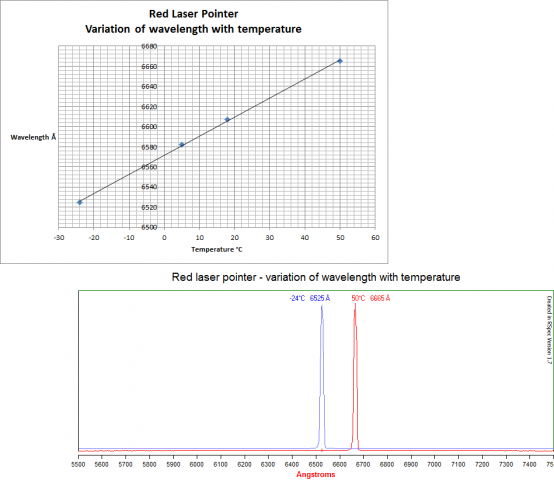 Hi Derek / Steve,
Hi Derek / Steve,A few years ago I used my Alpy 600 to look at the variation of wavelength of my red laser pointer with temperature, using my fridge/freezer and kitchen oven with a mercury thermometer. The results are attached, giving a variation of 0.19nm/deg
Cheers
Hugh
 Hugh AllenParticipant
Hugh AllenParticipantHi Robin,
Paul Roche wrote: “This is an unusual X-ray system, with a slow pulsar (~14 mins spin period) in a wide binary (~250 day) orbit, which exhibits phases where the Be star loses it’s circumstellar disc (characterised by unusally faint periods where the primary fades to V~6.9-7.0). X Per is generally a bright B0e star (V~6.4-6.7), and I’m interested in setting up a long term monitoring project to try and follow the system through it’s next disc-loss phase.”
I think a disc-loss phase may be underway. On a murky night a few days ago, I captured a rather noisy X Per spectrum of which I normally wouldn’t be proud, but with the poor weather I’ve had little opportunity this last couple of months! But it’s good enough to see a significant fade in the intensity of all of the emission lines from the disc since my last spectrum on 28th March. I also attach what Vmag data there is from the AAVSO website in which a significant dip in magnitude is also apparent.
Cheers
Hugh
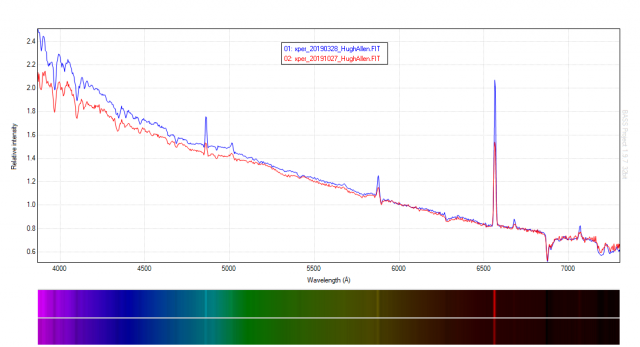
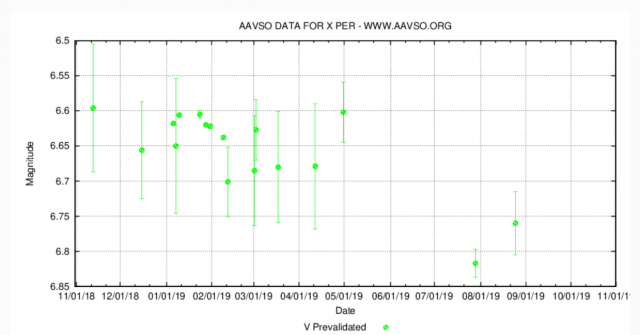
 Hugh AllenParticipant
Hugh AllenParticipantThanks Robin. I chatted to the editor Keith Cooper at this year’s Astrofest and explained how I felt amateur spectroscopy was largely ‘clouded out’ in astronomy magazines. He took me up on writing an article which I based around the talks that I give. It’s nice to help raise amateur spectroscopy’s profile a little.
Cheers
Hugh
 Hugh AllenParticipant
Hugh AllenParticipantHi James,
I don’t think Polaris is a good alignment star for Alt-Az telescopes. I have a fork-mounted Meade LX90, and Polaris is not in the list of recommended alignment stars in the handset. I vaguely recall trying Polaris in the early days and finding the 2-star alignment was less accurate. I think the other guidance is to avoid an alignment star when it is near the zenith (the tube is parallel to the forks) or below about 10deg elevation. Otherwise, provided the two stars are well separated in the sky then the Meade 2-star alignment is highly accurate every time (I use an illuminated cross-hair eyepiece to get the alignment star dead centre every time). I do spectroscopy with my Alt-Az Meade and using GoTo the target star drops every time into the field of view of my Alpy 600 guide unit.
Cheers
Hugh
 Hugh AllenParticipant
Hugh AllenParticipantHi Mike,
I have a fork-mounted Meade LX90 8″ which I set up from scratch every session. I use it in Alt-Az mode (not mounted on a wedge) which means it takes just 20 minutes to set up and 2-star align to give perfect pointing accuracy. Like you I have a Meade DSI II colour camera with which I have done all the astrophotography you can see on my Facebook page https://www.facebook.com/hugh.astrophotography/photos_albums So a lot can be achieved using the easiest set-up.
Cheers
Hugh
 Hugh AllenParticipant
Hugh AllenParticipantHi Robin,
I guess it’ll be in your full report but what was the altitude of Aldebaran in this case? I work in alt-az mode and orient my slit vertically which I think should minimise this effect?
Cheers
Hugh
P.S Just noticed your original post was a little while ago!
 Hugh AllenParticipant
Hugh AllenParticipant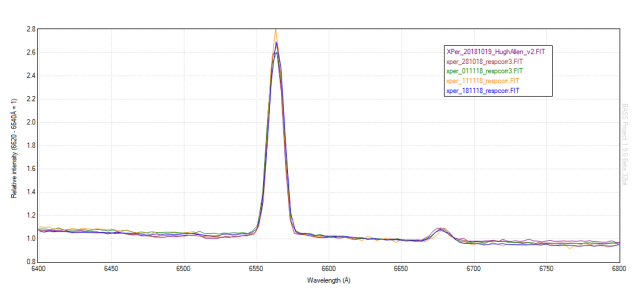 I now have about a month’s baseline spectra for monitoring the extent of more significant changes in the coming years…
I now have about a month’s baseline spectra for monitoring the extent of more significant changes in the coming years… Hugh AllenParticipant
Hugh AllenParticipantHi John,
The thread that you started has prompted me to re-visit the accuracy of my own Alpy calibration. I use BASS so calibration is a manual process. I use 13 lines from the Alpy calibration lamp spectrum and a 4th order polynomial. From my observing session a couple of nights ago the calibration lamp fit had an RMS of about 0.53A. I had selected SAO 25665 as reference star for X Per and b Per observations. SAO 25665 has a very low radial velocity according to SIMBAD, giving the spectra and results that I attach below. The calibration accuracy of the Balmer lines in the SAO 25665 spectrum is pretty good even into the near UV. And like you have found, the accuracy is worst, although still reasonable, for Hα. I wonder what could be the explanation for the dveiation in the Hα accuracy? By the way, I marked on the spectrum the position of the 13 calibration lamp lines that I use – I stack 3 x 40sec calibration lamp exposures.
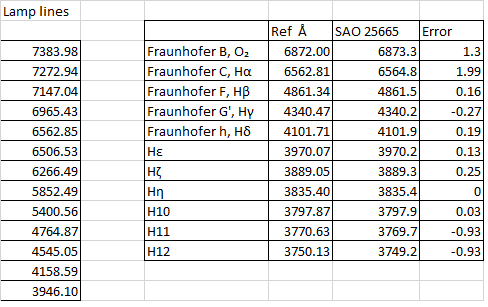

Cheers
Hugh
 Hugh AllenParticipant
Hugh AllenParticipantHi Peter
I run successfully Meade Autostar Suite Version 5.50 on a Windows 10 laptop
Cheers
Hugh
 Hugh AllenParticipant
Hugh AllenParticipant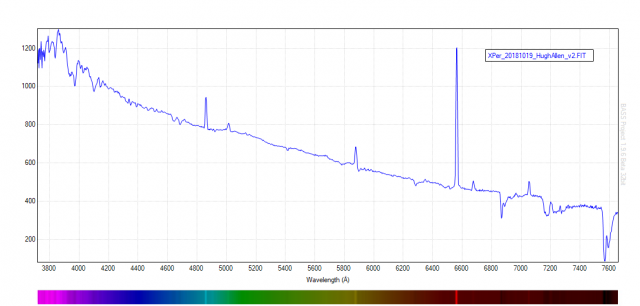
Hi again Robin,
Thanks for querying the response correction. There was indeed a very shallow dip in my response correction curve around 5000Å. So I revisited my response correction by applying the continuum response shaper in BASS from a more ‘distant’ perspective. I would normally smooth the response correction curve by zooming in on 2 sections, from 3600-5500Å and then continuing on to 5500-7700Å. In this second attempt I smoothed the curve in one view from 3600-7700Å. The shallow dip around 5000Å was much less visible in this revisited curve, although there is still an ‘undulation’ in the resulting X Per response corrected spectrum, so it would be interesting to compare with another low res spectrum on the BAA database if one appears. I always review the response corrected reference star spectrum against the library reference for obvious discrepancies but I should have questioned more the bump around the HeI emission. I have replaced my spectrum in the database with this newer v2.
Response correction of low res spectra can be a bit of an art form, especially at the near UV end where it can be like grasping the tail of a thrashing snake!
Thanks as ever for your guidance
Cheers
Hugh
 Hugh AllenParticipant
Hugh AllenParticipantHi Robin,
Here’s my recent Alpy spectrum of X Persei. I realise that the main interest is in higher resolution spectra centred on the Hα emission, but even at low resolution X Persei gives a beautiful spectrum peppered with interesting emission lines. I’ll aim to keep my eye on this star
Cheers
Hugh
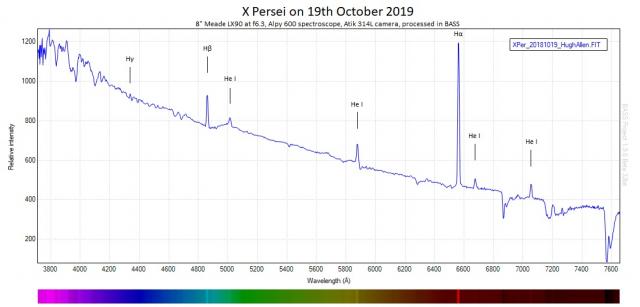
 Hugh AllenParticipant
Hugh AllenParticipant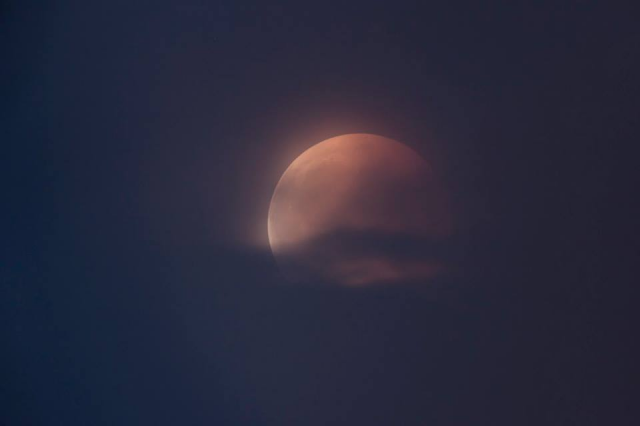 Wells & Mendip Astronomers held a lunar eclipse observing event at the Mendip Gliding Club on the southern lip of the Mendip Hills. We had superb views out over the Somerset Levels, Glastonbury Tor, The Quantocks….but the sky remained stubbornly cloudy. Then just as the phase of totality was about to end a small gap appeared in the clouds. Our ace, wide-field photographer member Josh Dury had his equipment at the ready and captured this beautiful image – surely one of the few images of totality captured from the UK!
Wells & Mendip Astronomers held a lunar eclipse observing event at the Mendip Gliding Club on the southern lip of the Mendip Hills. We had superb views out over the Somerset Levels, Glastonbury Tor, The Quantocks….but the sky remained stubbornly cloudy. Then just as the phase of totality was about to end a small gap appeared in the clouds. Our ace, wide-field photographer member Josh Dury had his equipment at the ready and captured this beautiful image – surely one of the few images of totality captured from the UK!Cheers
Hugh
 Hugh AllenParticipant
Hugh AllenParticipant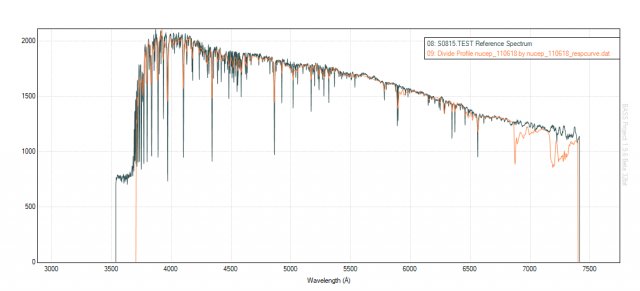 Hi John,
Hi John,That’s a very nice series of spectra, fascinating! I found that response correction takes a bit of practice before it all clicks. Here’s an example of the sort of agreement I got between my response corrected nu Cep reference star spectrum and the Miles database spectrum from last night (I am using nu Cep as the reference star for following the eclipsing binary VV Cep)
Cheers
Hugh
 Hugh AllenParticipant
Hugh AllenParticipantNick,
I think Demetra is ‘better’ than ISIS in terms of a more intuitive software. I was also a Demetra beta tester and the software was designed by Francois Cochard and Nicolas Durand to make the accurate processing of Alpy spectra as straightforward and reliable as possible and in that I think they brilliantly succeeded. BASS is a very intuitive software as well which I have used extensively for my data reduction. Both Demetra and BASS will help ensure that the complexity of data reduction is as low a barrier as possible to getting more people practicing amateur spectroscopy. That for me is their key attraction, whilst ISIS will remain the ‘gold standard’ in terms of, as Robin said, its flexibility and comprehensive performance
Cheers
Hugh
 Hugh AllenParticipant
Hugh AllenParticipantRobin,
I’m not sure of the best way to compare my two relative intensity spectra but here’s what I did for my spectra from 2nd and 6th May…
Cheers
Hugh
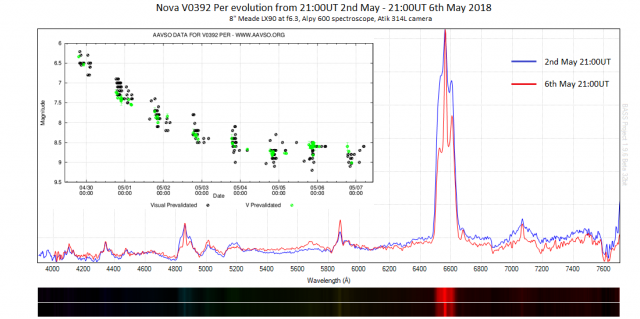
-
AuthorPosts
